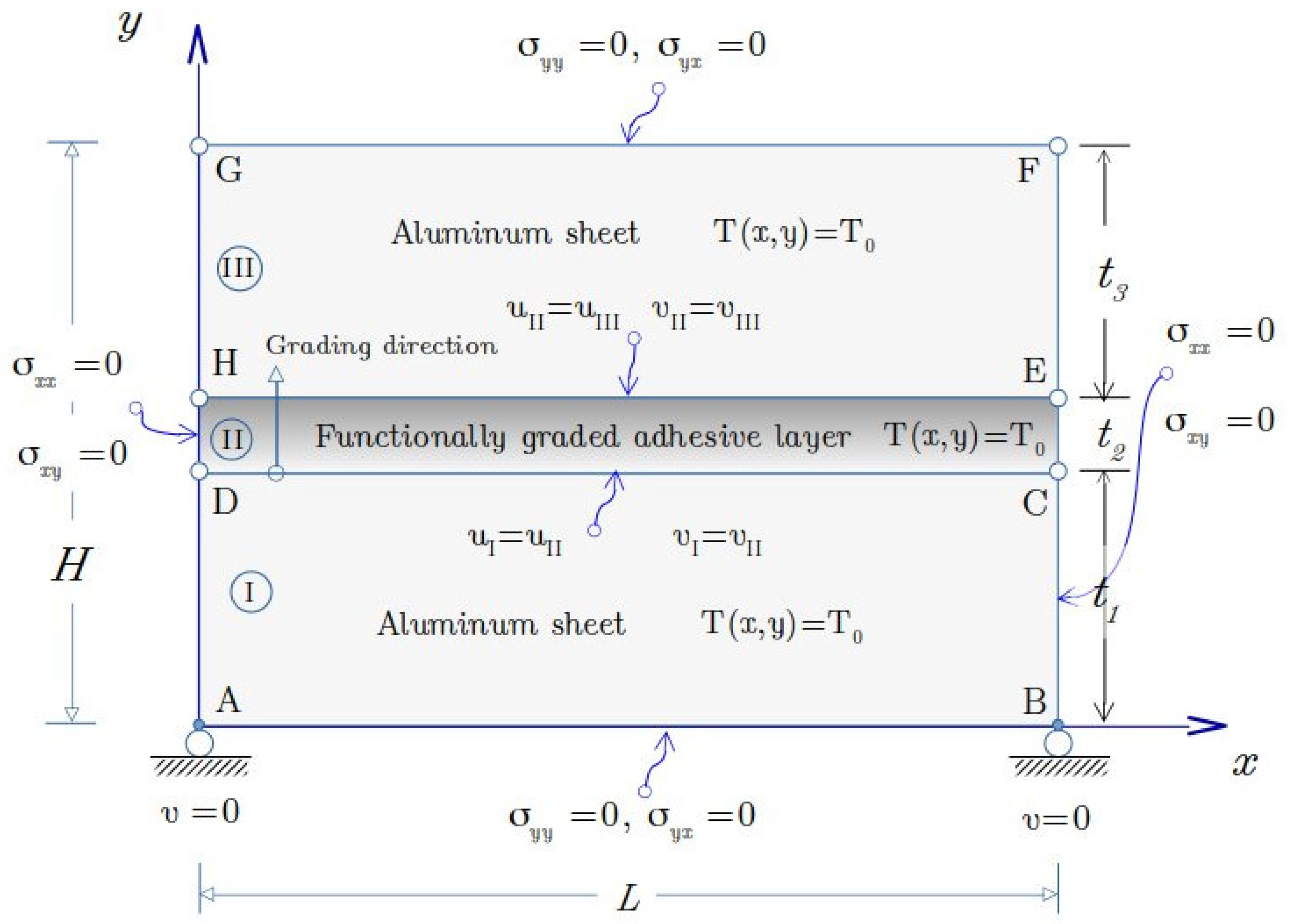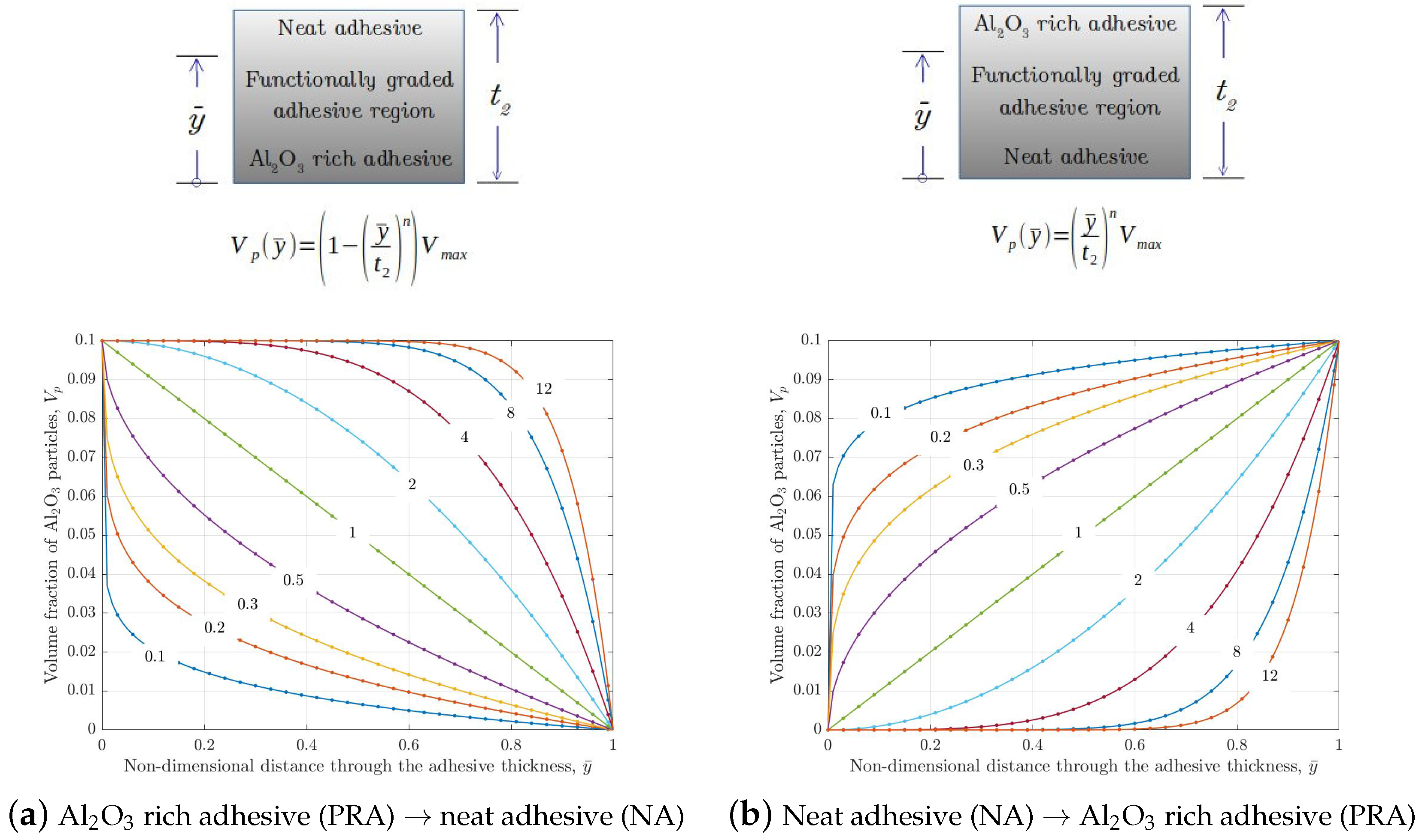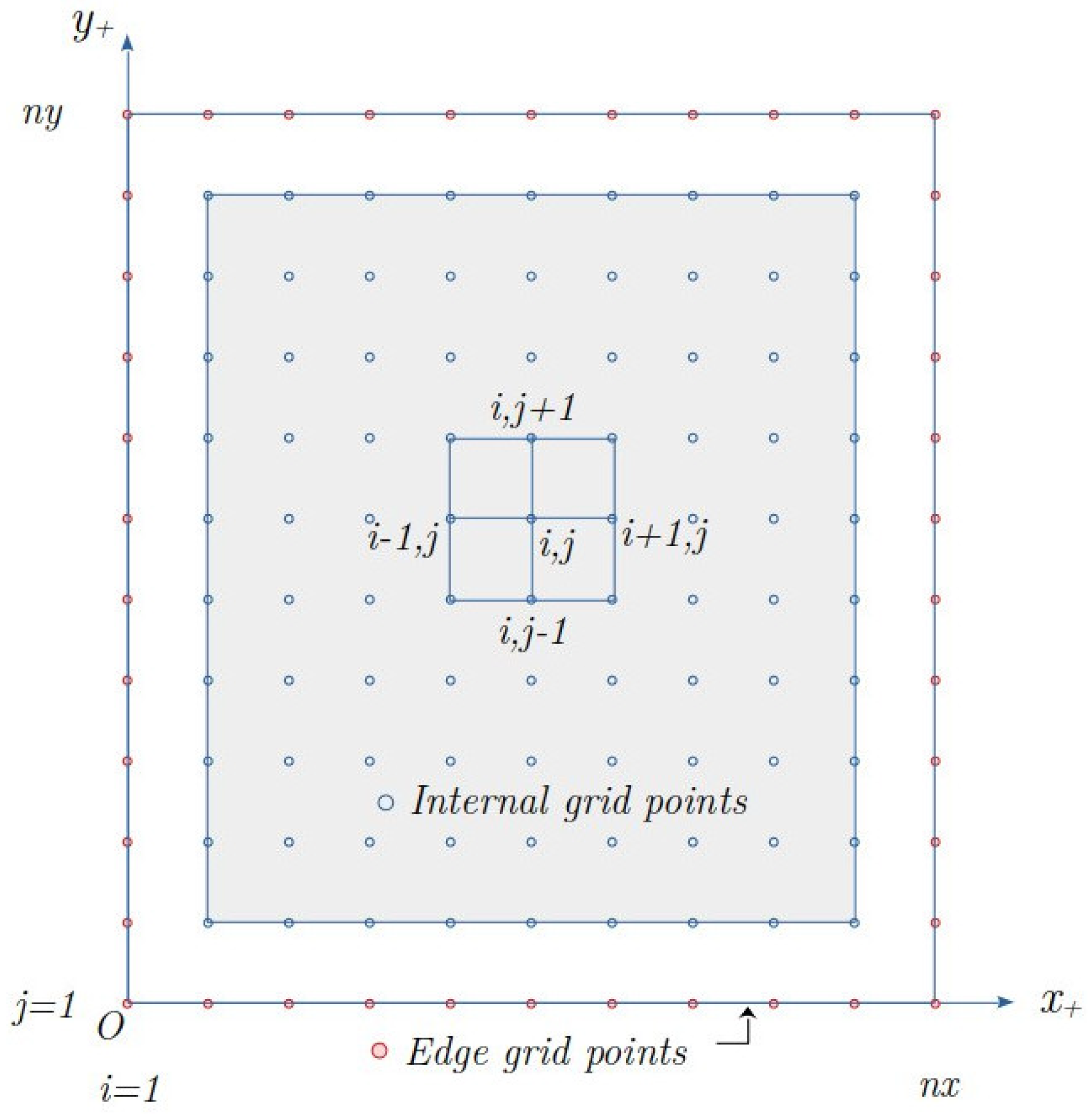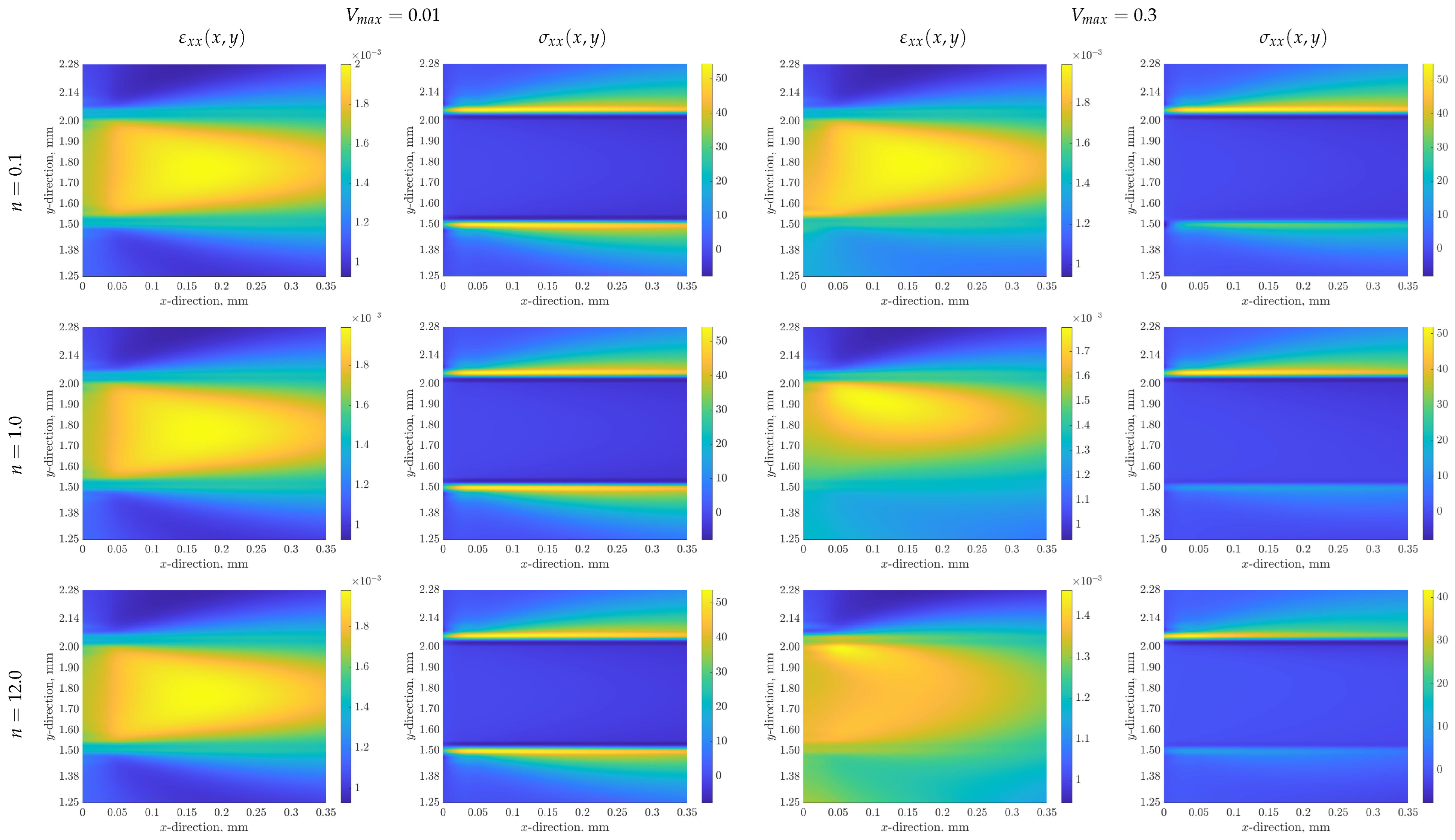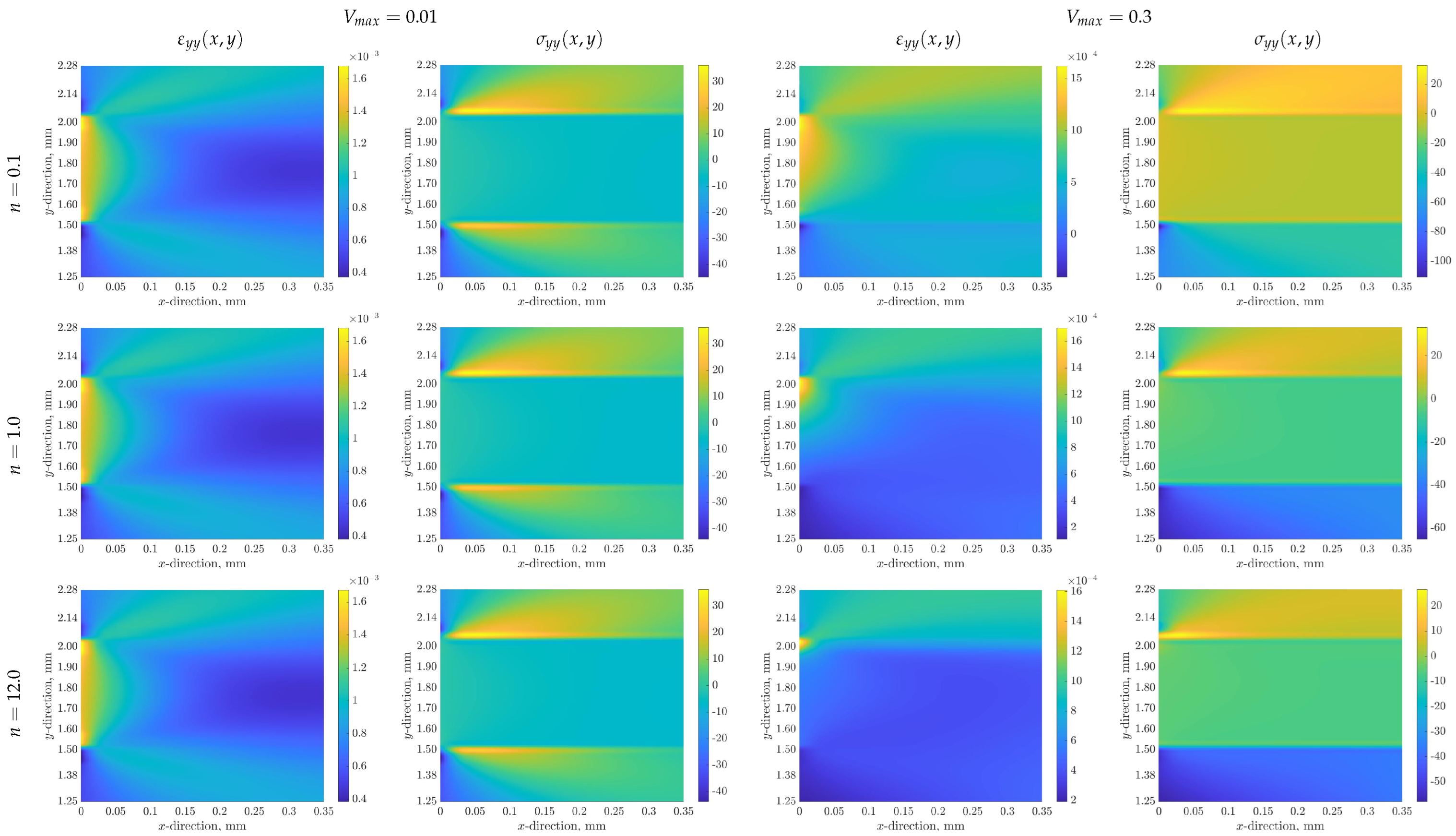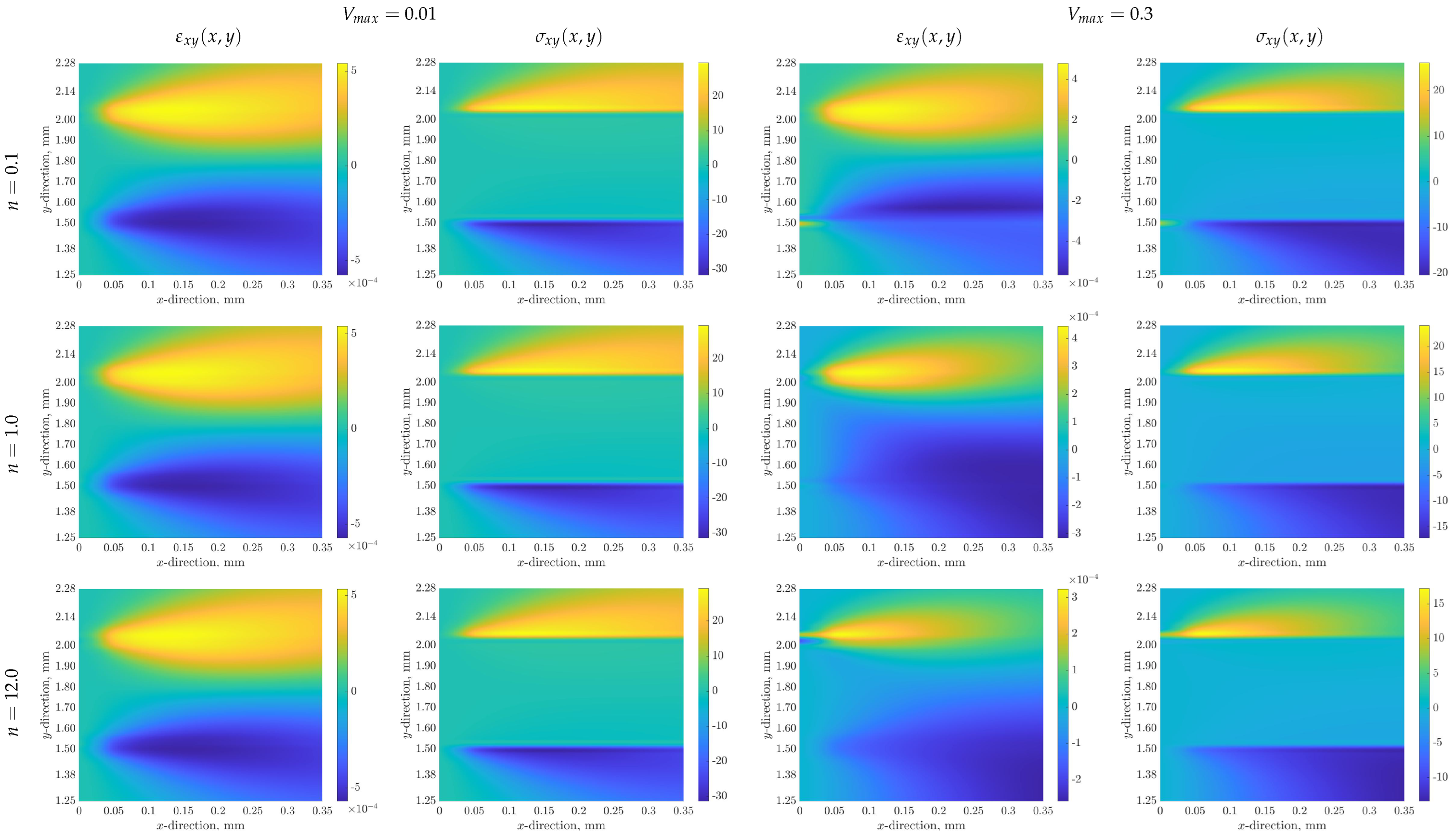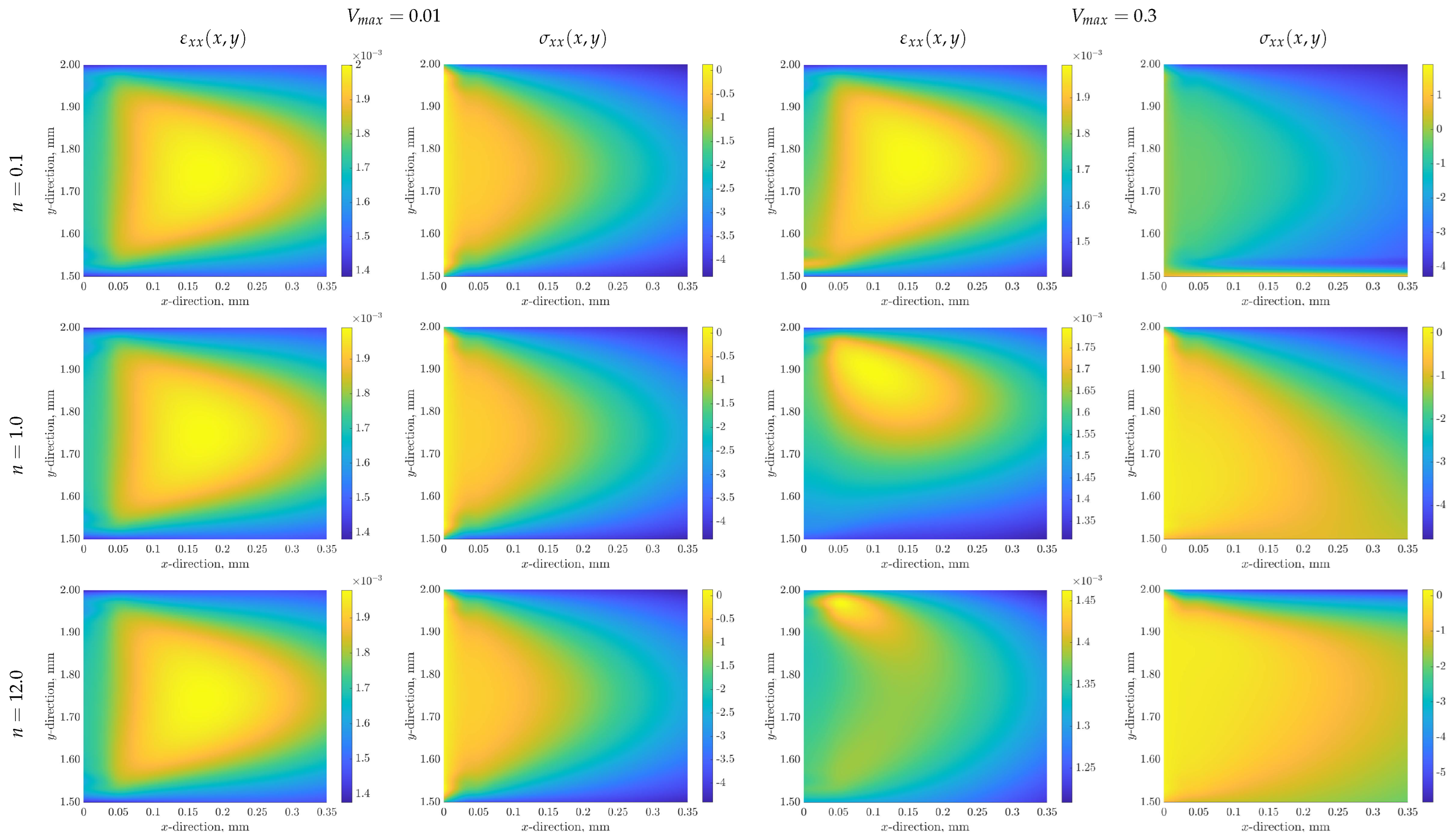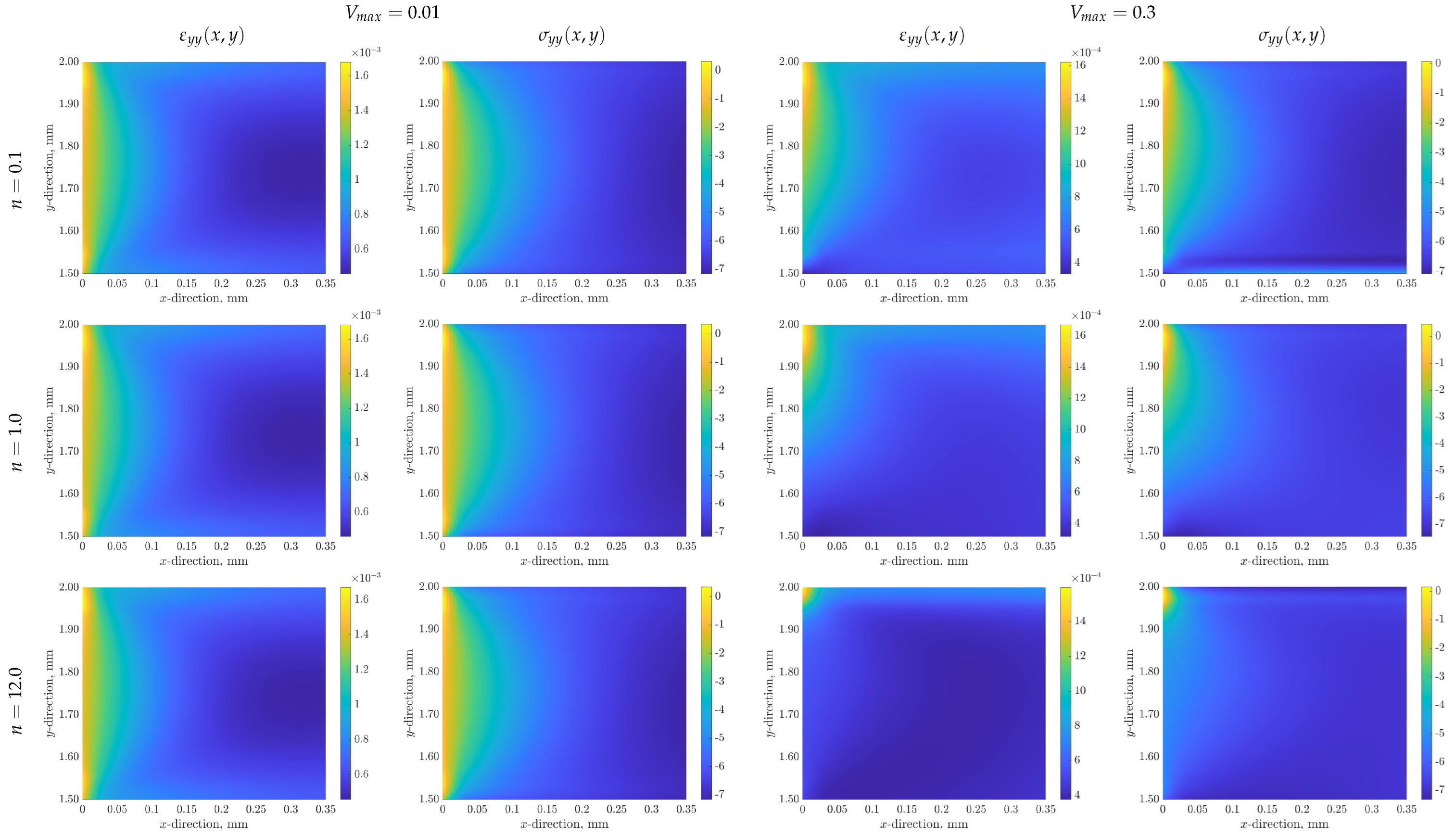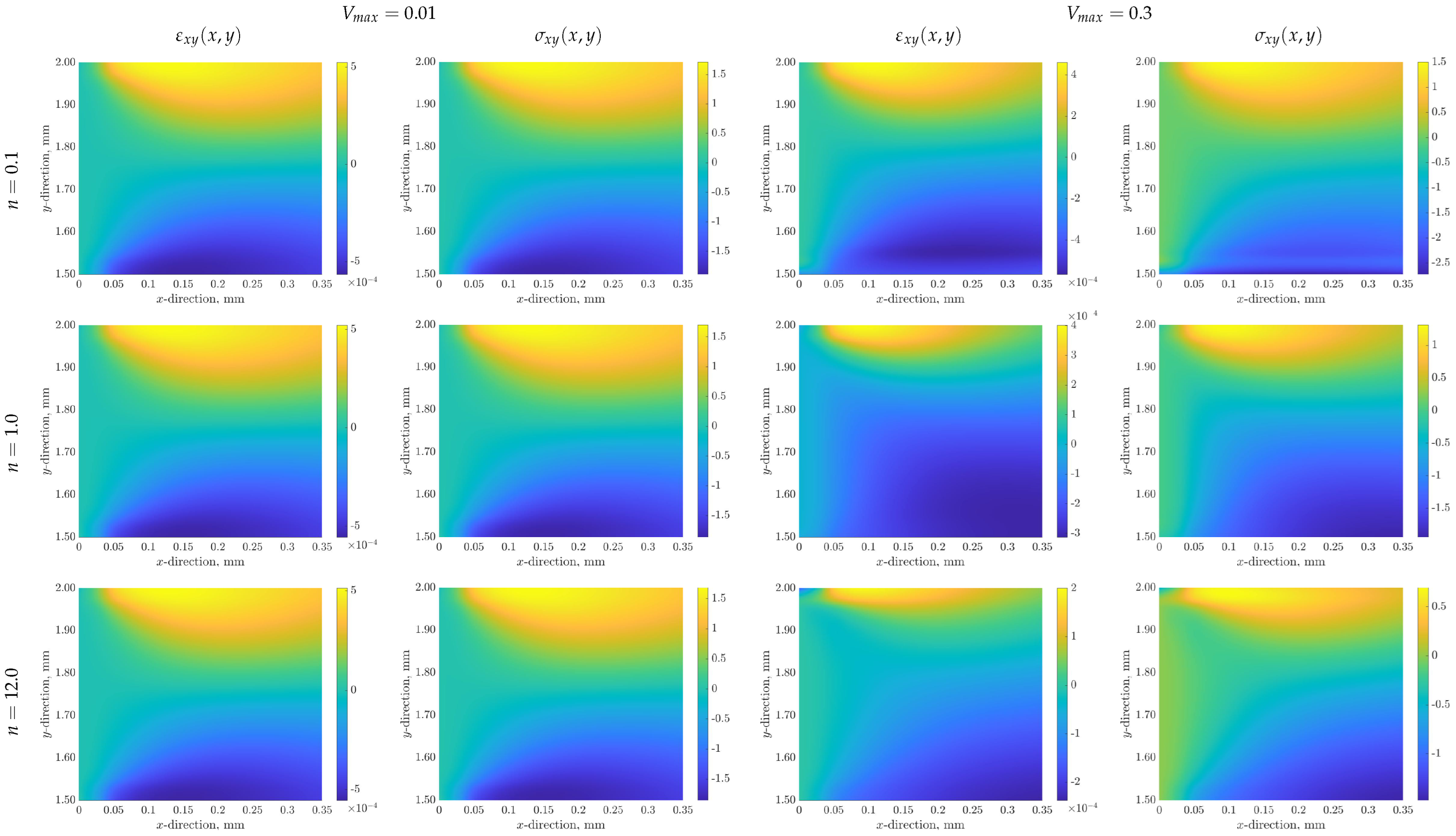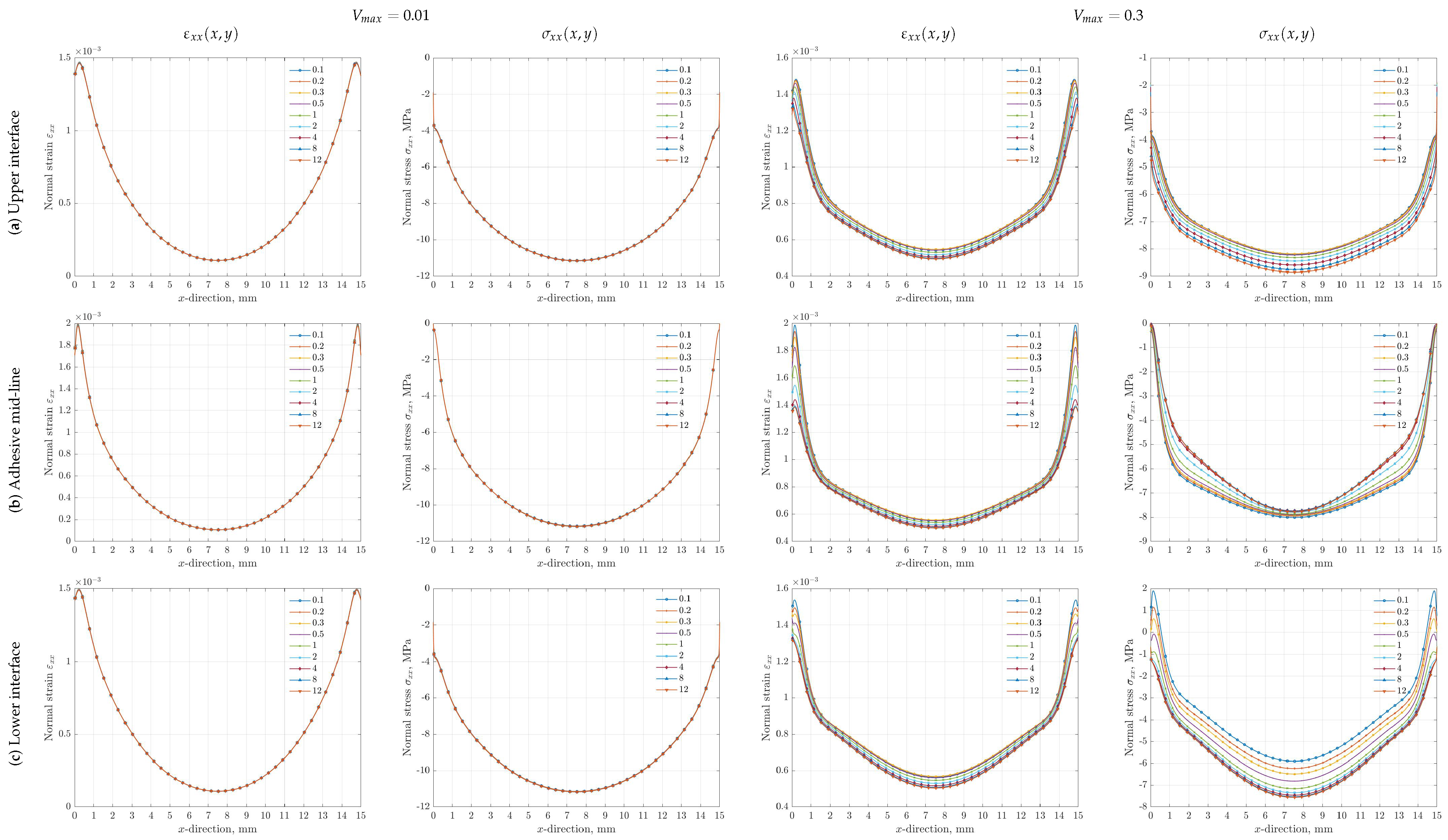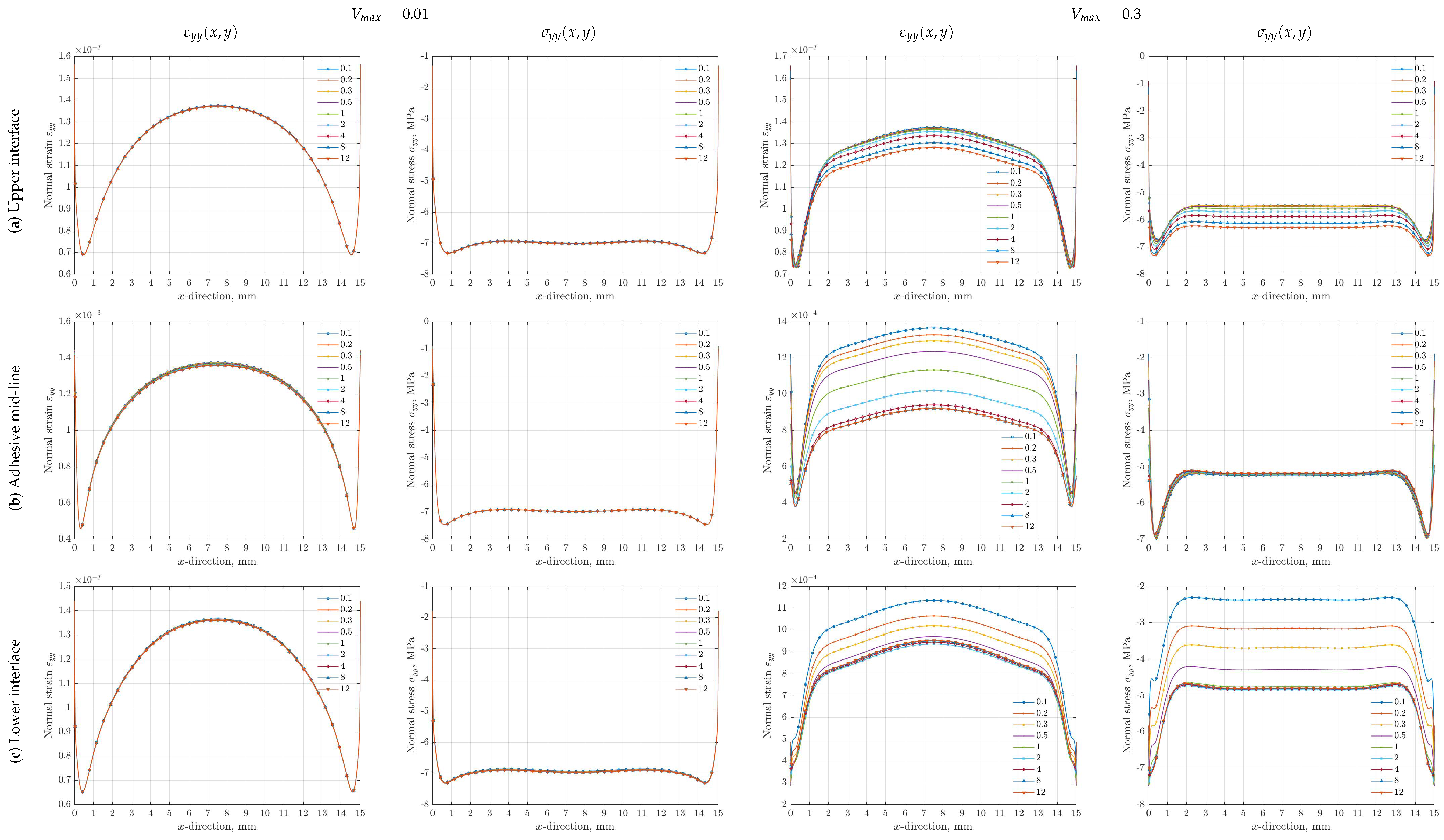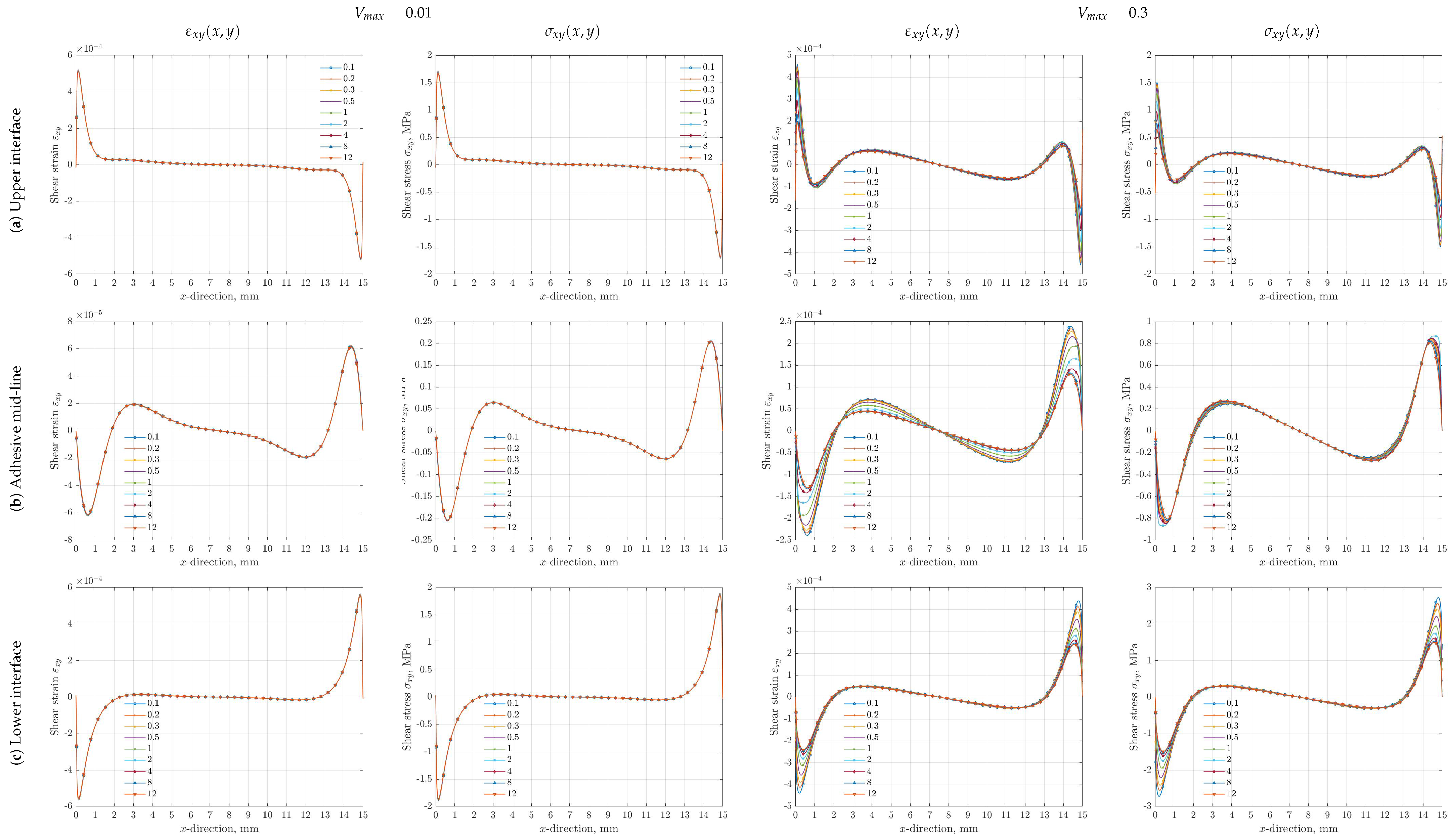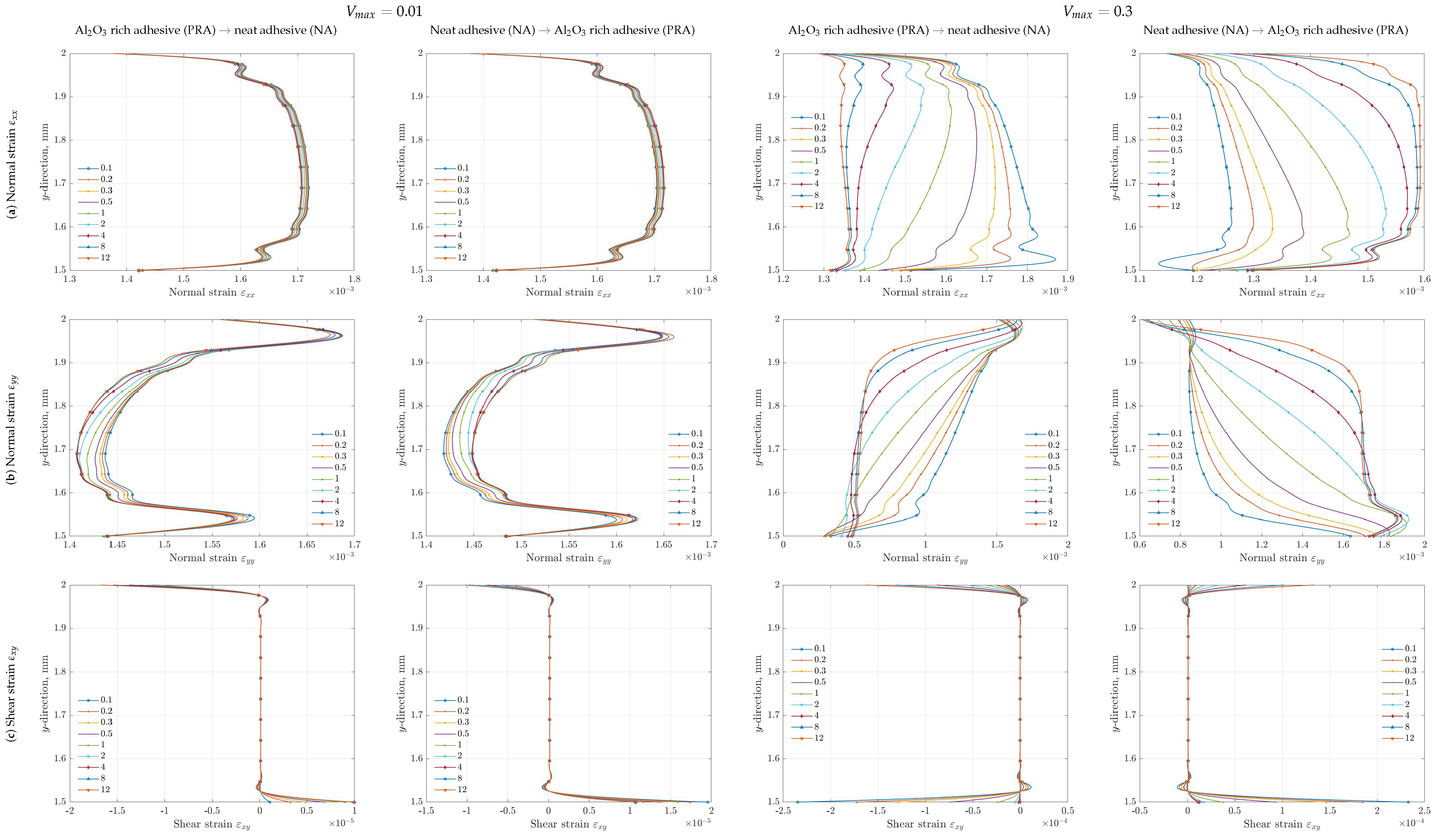1. Introduction
The adhesive bonding technique has been used successfully to join similar and different materials. In general, adhesive joints are designed so that they can withstand static and dynamic loadings [
1,
2]. However, today’s adhesives can serve at cryogenic, low, and high temperatures. The thermal loads result in non-uniform thermal stress distributions, which appear in a discontinuous manner in vicinities of adhesive–adherend interfaces due to incompatible thermal strains as a result of different mechanical and thermal properties of the materials on both sides of bi-material interfaces [
3]. A uniform or non-uniform temperature distribution, a non-uniform material property distribution, chemical and physical changes induced in the adhesive material during the adhesive curing process, the expansion of adhesive with changes in moisture and temperature levels also result in thermal stresses in adhesive joints [
4,
5].
In various types of mechanical loadings, the adhesive joints undergo stress concentrations, called edge effects, around the free edges of adhesive–adherend interfaces while the normal and shear stresses remain uniform at low levels in a large overlap region and increase uniformly towards the free edges of the adhesive layer and then become peak near these free edges. A large overlap region can also experience high stresses except for the adhesive-free edges depending on the type of thermal loading. In order to reduce the stress concentrations and to improve the joint strength, some joint geometry-specific measures were considered by adjusting the stiffness of adherends around these critical regions. However, the proposed geometrical measures to relieve these peak stresses can cause losses in the overall stiffness and strength of adhesive joint [
1,
2,
6].
A layered composite structure, which can be joined easily by adhesive bonding technique, can exhibit better thermal and mechanical properties to single-composite material. Nevertheless, a thermal load can result in critical stress concentrations occurring along bi-material interfaces due to the sharp discontinuities in the material properties [
7,
8]. The concept of functionally graded materials (FGMs) is already utilized by biological interfaces in nature in order to reduce stress concentrations along bi-material interfaces. FGMs aim to achieve an equivalent performance to that of single-phase materials by unifying the better properties of the constituent phases with one- or more-dimensional continuously varying material composition; consequently, this can remove sharp discontinuity along the bi-material interface and relieve sudden jumps in the thermal stresses along bi-material interfaces [
9,
10,
11].
Although the concept of FGMs is new, a large number of research studies have been carried out, and this field continues to expand fast [
12,
13]. Today, this concept can also be implemented to reduce stress concentrations appearing along the adherend–adhesive interfaces of the adhesive joints serving under static, dynamic, and thermal loads, i.e., use of functionally graded adherends and adhesives [
14]. The stress distribution and peak stress levels can be controlled by tailoring one- or two-dimensional composition variation of adherends as well as an adhesive with one or more other constituents [
14,
15,
16]. This method is especially helpful for relieving thermal stresses due to thermal loads.
Mathematical models and solutions on the thermal residual stress analysis of adhesive joints with functionally graded adherends have been continuously improved, and the functionally graded adherends were reported to relieve both stress and strain distributions and levels in the adhesive layer as well as in the adherends even though the adhesive layer was still in a functionally ungraded state [
17].
An adhesive layer with variable modulus, which requires at least the use of two adhesives with different mechanical and thermal properties, has been proposed to relieve high-stress concentrations at the free edges of the adhesive layer and to have more uniform stress distributions along the overlap region [
18,
19,
20,
21,
22,
23]. This can be considered as a stepped functionally graded adhesive layer; namely, a stiff adhesive in the middle portion of the overlap region and a flexible adhesive around the free edges of the overlap region are applied. The concept of using multi-modulus adhesives can improve the overall joint strength and can also be implemented to the thermal stress problems of the adhesive joints to operate at low and high temperatures [
24]. Namely, a high-temperature adhesive in the middle of the overlap region keeps the strength by transferring the entire load, whereas a low-temperature adhesive withstands loads at low temperatures by causing the high-temperature adhesive to undergo moderate stress levels [
18,
25,
26].
The dual or mixed adhesive technique also brings some drawbacks. The stiff adhesive may tend to displace the ductile adhesive under the applied pressure; therefore, the bonded joint may be worse off than using the ductile adhesive alone in the manufacturing stage [
18]. Another common method is to add various reinforcements of different scales, which are harder, stiffer, and more strength than adhesive material, to the adhesive layer. Therefore, the mechanical properties, electrical and thermal conductivities of adhesive material can be improved suitably depending on its application area [
27]. In general various fillers at a specific weight/volume fraction are distributed uniformly through adhesive material, and a homogeneous distribution of fillers is desired as possible. The stress analyses of this reinforced adhesive layer under mechanical and thermal loadings are performed using its mechanical and thermal properties, which are predicted by various experimental or continuum mechanics-based homogenization methods [
28,
29,
30,
31].
New theoretical analyses propose the use of a continuous adhesive grading, such as for modulus or coefficient of thermal expansion, along one or two coordinate directions of the adhesive material, and indicate that the improved strength of adhesive joints can be achieved by controlling stress concentrations with an existing optimum material grading rule [
14,
15]. Nevertheless, the material grading distribution rules are not practical right now for production purposes. The implementation of fused deposition modeling (3D printing) to the adhesive joints is now promising for the production of a functionally graded adhesive layer [
32,
33,
34,
35]. Consequently, the practice of functionally graded adhesive is still in the development stage and needs many theoretical and experimental studies that consider all aspects of adhesive material and adhesive joint.
In this study, the strain and stress states in an aluminum single lap joint bonded with a through-thickness functionally graded Al
O
micro particle reinforced adhesive layer were investigated under a uniform temperature field (
Figure 1). The spatial derivatives of Lamé constants and the coefficient of thermal expansion of local adhesive composition were considered in Navier equations of two-dimensional elasticity theory. The mechanical and thermal properties of the local adhesive composition were predicted by Mori–Tanaka’s homogenization approach. The set of partial differential equations was solved with mechanical boundary conditions at each grid point of a discretized joint using the central finite difference approach. The effect of gradient power index controlling the through-thickness volume-fraction variation of particles in the local adhesive composition was also analyzed on the strain and stress states of the adhesive layer and adherends.
4. Results and Discussion
The geometry, dimensions, and boundary conditions of an aluminum single lap joint bonded with a functionally graded adhesive are shown in
Figure 1. The joint length
mm, aluminum adherend thickness
mm, and adhesive thickness
mm. The displacements of the left and right lower corners are fixed only in the
direction, and the normal and shear stresses are considered as zero along the free edges of the adhesive joint. A constant temperature change of
°C is assumed at all grid points. The thermal and mechanical properties of adherend, micro-sized powder, and adhesive materials are given in
Table 1. The solution domain was discretized into a mesh grid of 631 × 150 with increments of
mm along the
x- and
y-directions, respectively.
The composition of functionally graded adhesive consists of (Al
O
) micro-particles and two-component epoxy-based adhesive mixed at specific volume fractions. The volume fraction of micro-particles
through the thickness of the adhesive layer is tailored by obeying a power rule including a gradient power index
n (Equation (
2)). Two grading directions are also considered, thus, the variations of volume fraction of particles through the adhesive thickness between a particle-rich adhesive around the lower interface and a neat adhesive around the upper interface (PRA→NA,
Figure 2a), and between a neat adhesive around the lower interface and a particle-rich adhesive around the upper interface (NA→PRA,
Figure 2b), respectively. The volume fraction of particles
around the particle-rich adhesive interface is limited by the maximum volume fraction of particles as
because the adhesion between adhesive and aluminum adherend has not deteriorated. The volume fraction of particles
can have a desired through-thickness form with the power index
and
(
Figure 2).
Consequently, this study aims to determine the effects of the gradient power index n, maximum volume fraction , and grading direction through the adhesive thickness on the adhesive strain and stress distributions induced by a uniform temperature change through the adhesive joint and on reliving their critical levels. The thermal stress analyses were carried out for various maximum volume fractions of particles and power index values. The strain and stress components exhibited almost similar distributions except for their levels of low-volume fractions of particles. The left and right free edges of the adhesive layer appeared as symmetrical stress and strain concentration regions. Therefore, the distributions of strain and stress components will be discussed via their contour plots.
Figure 4,
Figure 5 and
Figure 6 show the effects of the power index
and the maximum volume fraction of particles
on the distributions of strain
and stress
components around the left free ends of both lower and upper interfaces of a functionally graded adhesive layer. The normal strain
concentrates around the lower and upper adhesive interfaces, propagates towards the overlapping center, and decreases uniformly (
Figure 4). A graded variation of normal strain appears, especially in the vicinity of both interfaces. The free edges of the adhesive layer undergo higher normal strain levels than two adherends because the overall coefficient of thermal expansion of adhesive composition is larger than those of aluminum adherends. Similar symmetrical distributions also appear around the right-hand sides of both interfaces. The general form of distributions is not affected by the power index
n for a low maximum volume fraction (
), while its effect becomes more apparent for a through-thickness quite particle-rich composition (
). The normal strain levels decrease as the adhesive is enriched by particles through the adhesive thickness (
). Thus, the higher strain levels occur around the free end of the upper interface and in the vicinity of this interface. The normal strain decreases slightly through the adhesive thickness towards the vicinity of the lower interface. The normal strain distribution exhibits a dependency on the through-thickness variation of particles in the adhesive composition. The normal stress
concentrates in the vicinity of both interfaces and exhibits discontinuous distributions at different levels on the adherend and adhesive sides of interfaces (
Figure 4). The normal stress levels in the adhesive layer are rather lower than in the adherends because aluminum adherends are of higher modulus than the adhesive composition. The normal stress distribution and levels remain similar for a low maximum volume fraction of particles (0.01), and the effect of the power index is negligible. The power index has a more apparent effect on the normal stress distributions and levels for a high volume fraction of particles (0.3). Namely, the higher stress levels occur on the adherend side in the vicinity of the neat adhesive–upper adherend interface in comparison with those around the particle-rich adhesive–lower adherend interface as the adhesive is enriched by particles through its thickness.
The normal strain
exhibits similar distributions; thus, the concentration zones appear around the free edges of the adhesive layer and both adhesive interfaces, and then continuously relieve through the adherend and adhesive regions neighboring to the interfaces towards the center of overlap region (
Figure 5). Especially, the concentration regions around the free ends of the adhesive layer expand through the adhesive thickness towards the center of the overlap region. The normal strain decreases along a symmetrical diffusing band-form region on the adherend sides of two interfaces. The normal strain levels are higher in the adhesive layer because the adhesive layer is of a larger overall coefficient of thermal expansion. The distribution manner and levels of the normal strain
around the free edges of the adhesive layer, and both interfaces are not affected notably by the power index for a low maximum volume fraction of particles (0.01). The power index becomes more effective on the normal strain distributions and levels for a high volume fraction of particles (0.3). Namely, the strain concentration zone at the adhesive-free edge gets narrower towards the free end of the upper neat adhesive–adherend interface, and occurs in the vicinity of this interface towards the center of the overlap region. In addition, the diffusing zone in the upper adherend becomes more apparent in comparison with those in the lower adherend as the adhesive is enriched by particles through its thickness. The normal stress
exhibits concentration zones with discontinuous distributions in the vicinity of both interfaces and different levels on the adherend and adhesive sides of interfaces (
Figure 5). The normal stress levels in the adhesive layer are rather lower, whereas the adherend regions neighboring both interfaces undergo higher stress levels diffusing towards the center of the overlap region and through adherend thickness. The normal stress distribution and levels remain similar, and the effect of the power index is negligible for a low maximum volume fraction of particles (0.01). However, the power index affects evidently the normal stress distributions and levels only for a high volume fraction of particles (0.3). The higher tensile stress levels occur on the adherend side in the vicinity of the neat adhesive–upper adherend interface, whereas the higher compressive stress levels occur on the adherend side in the vicinity of the particle-rich adhesive–lower adherend interface. The high-stress levels relieve considerably in these concentration zones as the adhesive is enriched by particles through its thickness.
The shear strain
concentrates in the neighborhood of both interfaces except their free edges (
Figure 6). A narrow concentration zone initiates at a small distance from the free ends of both interfaces and expands through the adherend and adhesive thicknesses. The shear deformations occur symmetrically but in opposite directions along the lower and upper interfaces. The power index has a negligible effect on both distribution manner and levels of the shear strain
around the free edges of the adhesive layer and both interfaces for a low maximum volume fraction of particles (0.01), whereas this effect becomes apparent on the shear strain distributions and levels for a high volume fraction of particles (0.3). Thus, the symmetrical concentration zones near both interfaces degenerate, and the shear strain levels around the neat adhesive–upper adherend interface reach partly higher levels, and the shear strain levels decrease as the through-thickness adhesive composition is enriched by particles. The neat adhesive interface forces the neighboring zones of both adhesive and adherend to more deformation in shear due to its tendency to a larger thermal expansion. The shear stress
concentrations occur in the neighborhood of both interfaces except their free edges and exhibit a discontinuous distribution along both interfaces (
Figure 6). The adherend side experiences higher shear stresses than those on the adhesive side. The shear strain and stress distributions are conformable. The effect of the power index becomes apparent on the shear stress
distributions and levels in the regions near both interfaces only for a high volume fraction of particles (0.3). The symmetrical concentration zones near both interfaces become smaller towards the free ends of both interfaces, and the shear stress levels decrease as the through-thickness adhesive composition is enriched by particles. The shear stress is also as critical as the normal stresses. In general, a ductile adhesive composition is expected to tend to damage in shear.
In case an adhesive single lap joint is subjected to a uniform temperature distribution, the strain and stress components concentrate in the neighborhood of adherend–adhesive interfaces and around their free edges. They also decrease uniformly along the interfaces towards the center of the overlap region. The normal and shear strain components exhibit grading distributions along both bi-material interfaces, whereas the normal and shear stresses are of a discontinuous nature. Since the adhesive material is generally assumed to be a material of lower strength than adherends; hereafter, the evaluation of normal/shear strain and stress distributions around the free edges of the adhesive layer is in evidence as a more convenient way.
Figure 7,
Figure 8 and
Figure 9 show the effects of both gradient power index
and maximum volume fraction of particles
on the distributions of strain
and stress
components around the left free end of a functionally graded adhesive layer. The normal strain
distributions are symmetrical with respect to the adhesive mid-line (
Figure 7) for a low maximum volume fraction of particles (0.01). The high normal strain levels occur in a large adhesive zone in the vicinity of adhesive mid-line from at a small distance from the free ends of both interfaces and decrease uniformly towards the center of the overlap region. The power index exhibits a negligible effect on the normal strain distribution and levels for a low maximum volume fraction of particles. Increasing the maximum volume fractions of particles makes the effect of the power index to become more apparent. As the power index is increased, namely, the through-thickness adhesive composition is enriched by particles, the symmetrical distribution of normal strain disappears, and the concentration region contracts towards the neat adhesive–upper adherend interface. This indicates a reduced overall thermal expansion of remaining adhesive regions enriched by particles. The normal stress
acts in compression and is negligible near the adhesive-free ends. It increases through a limited expanding adhesive region towards the center of the overlap region in a symmetrical manner with respect to the adhesive mid-line (
Figure 7) for a low maximum volume fraction of particles. In addition, the adhesive regions near the interfaces experience higher compressive stress levels. As the local adhesive composition through the adhesive thickness is enriched by particles, the power index has a negligible effect on the normal stress distribution and levels. However, a high maximum volume fraction of particles reveals the effect of the power index. The normal stress distribution is not symmetrical anymore with respect to the adhesive mid-line, and a larger adhesive region undergoes lower stress levels. The adhesive regions near the neat adhesive–adherend interface experience still higher compressive stress levels while the stress levels decrease apparently in the adhesive regions near the lower particle-rich adhesive–adherend interface with increasing power index.
The normal strain
distributions are also symmetrical with respect to the adhesive mid-line and concentrate around the free ends of the adhesive layer, lower and upper interfaces. It decreases uniformly towards the center of the overlap region (
Figure 8). The remaining adhesive regions undergo lower normal strain levels. For a low maximum volume fraction of particles, the power index is of a small effect on the normal strain distribution and levels. The symmetrical distribution with respect to the adhesive mid-line disappears, and the high strain concentration zones distribute from the adhesive mid-line towards the free end of neat adhesive–upper adherend interface for a high maximum volume fraction of particles (0.3). The power index affects also the through-thickness variation of normal strain; thus, the normal strain levels are formed depending on the variation of volume fraction of particles through the adhesive thickness, and the strain concentration zone contracts around the free end of the neat adhesive–upper adherend interface. The adhesive zones near the neat adhesive–upper adherend interface experience higher normal strain levels and decrease uniformly towards the particle-rich adhesive–lower adherend interface. The normal stress
distributions (
Figure 8) also conform with those of the normal strain
. The adhesive layer undergoes compressive stresses except for the adhesive-free edge. Symmetrical distribution of normal stress appears with respect to the adhesive mid-line for a low maximum volume fraction of particles. The power index has a negligible effect on both normal stress distribution and levels. However, the lower normal stress zones around the adhesive free end contract around the free end of the neat adhesive–upper adherend interface as the local adhesive composition through the adhesive thickness is enriched by particles for a higher maximum volume fraction of particles (0.3). The power index is more effective on the normal stress distribution and levels. The remaining adhesive regions undergo compressive stresses, which increase uniformly towards the free end of the particle-rich adhesive–lower adherend interface, while the normal stress levels increase slightly because Al
O
particles with high modulus improve the overall modulus of the local adhesive composition.
The shear strain
is of a symmetrical distribution with respect to the adhesive mid-line, which concentrates on the free ends of the lower and upper interfaces and expands uniformly through the adhesive regions near both interfaces towards the adhesive mid-line and the center of overlap region (
Figure 9). The shear strain acts in opposite directions in the upper and lower adhesive portions. The remaining adhesive regions towards the center of the overlap region undergo negligible shear strain distributions. For a low maximum volume fraction of particles, the power index has a negligible effect on the shear strain distribution and levels, whereas a higher maximum volume fraction of particles (0.3) affects both shear strain distribution and levels. Namely, as the through-thickness adhesive composition is enriched by particles, the symmetrical distribution of shear strain degenerates fully, the high shear strain region in the adhesive upper portion contracts a narrower adhesive region near the upper neat adhesive–adherend interface and expands along the neighborhood of this interface towards the center of the overlap region. The shear strain levels also decrease uniformly, and its distribution is formed according to the variation of particle volume fraction through the adhesive thickness. The shear stress
exhibits a symmetrical distribution with respect to the adhesive mid-line, concentrates around the free ends of the lower and upper interfaces, and high shear stress regions expand through the adhesive thickness uniformly towards the adhesive mid-line (
Figure 9). The shear stress acts in opposite directions in the upper and lower adhesive portions. A large of the remaining overlap region experiences negligible shear stress levels. The shear stress distributions are less critical than those of two normal stress components. For a low maximum volume fraction of particles (0.01), the power index has a negligible effect on the shear stress distribution and levels. A higher maximum volume fraction of particles results in the effect of the power index becoming more apparent in the shear stress distribution and levels. Namely, the symmetrical shear stress distribution disappears, and the shear stresses in the particle-rich adhesive regions become more apparent. As the adhesive composition is enriched by particles, the shear stress levels decrease uniformly.
The free ends of the adhesive layer and the vicinities of the two interfaces appear as critical adhesive regions due to the high normal and shear strains. Therefore, the probable initiation of damage can be expected in these regions. The through-thickness distribution and levels of strain and stress components are also formed depending on the variation of particle volume fraction through the adhesive thickness. However, the effect of the power index becomes negligible, especially for a lower maximum volume fraction of particles. In order to determine the effects of the maximum volume fraction of particles limiting the number of particles in the local adhesive composition and the power index n tailoring the variation of volume fraction of particles through the adhesive thickness the variations of stress and strain components were evaluated along the upper aluminum adherend and lower aluminum adherend–adhesive interfaces (adhesive sides) and the adhesive mid-line. A grading direction was designated from the particle-rich adhesive–lower adherend interface to the neat adhesive–upper adherend interface.
The normal strain
increases uniformly from low levels in the center of the overlap region towards the free edges of the adhesive layer and becomes peak near the free edges (
Figure 10). Similar variations appear along the lower and upper interfaces and the adhesive mid-line for all power index values. The normal strain levels are lower along both interfaces than those along the adhesive mid-line. The normal stress
acts in compression and remains at high levels in a large overlap region and decreases towards the free edges of the adhesive layer, and then reaches zero levels (
Figure 10). The effect of the power index becomes apparent on the normal strain and stress levels only for a high maximum volume fraction of particles, namely, the normal strain variations along the interfaces and adhesive mid-line are similar, but their levels decrease with increasing power index. The neat adhesive–upper adherend interface experiences higher normal stresses than the particle-rich adhesive–lower adherend interface. The power index affects normal stress levels rather than variation forms. The normal stress levels increase partly with increasing power index (enriched adhesive composition by particles) and decrease through the adhesive thickness from the neat adhesive–upper adherend interface to the particle-rich adhesive–lower adherend interface.
The normal strain
exhibits almost high levels in a large overlap region and decreases towards the free edges of the adhesive layer and then reaches peak levels suddenly at the free edges (
Figure 11). Even though a similar behavior is observed along both interfaces and adhesive mid-line, the variation form remains similar, but the normal strain levels along the interfaces are partly higher. For a higher maximum volume fraction of particles (0.3), enriching the adhesive composition by particles results in apparent changes in normal strain levels rather than their variation forms, especially along the adhesive mid-line and the particle-rich adhesive–lower adherend interface. The normal strain
is more critical in a large overlap region in comparison to the adhesive-free edges. The normal stress
acts in compression and exhibits similar variations along the lower and upper interfaces and the adhesive mid-line, stays uniform at higher levels in a large overlap region and decreases uniformly towards the adhesive-free edges (
Figure 11). The power index exhibits a negligible effect on the normal stress variations and levels for a low maximum volume fraction of particles. However, its influence becomes evident in the variation form and levels of normal stress, especially along the lower and upper interfaces, as the through-thickness adhesive composition is enriched by particles for a high maximum volume fraction of particles. A particle-rich adhesive composition variation results in lower normal strains but higher normal stresses.
The shear strain
is uniform at negligible levels in a large overlap region and increases suddenly in the vicinity of the adhesive-free edges, and then decreases to zero levels at the adhesive-free edges (
Figure 12). A symmetrical variation appears with respect to the center of the overlap region but in the opposite sense along both interfaces and adhesive mid-line. The lower and upper interfaces are of similar variations and levels but in the opposite sense. The shear strain exhibits a uniform increase along the adhesive mid-line in the center of the overlap region. In general, the power index and the maximum volume fraction of particles have a minor influence on the variations and levels of shear strain along both interfaces and adhesive mid-line. However, the peak values at the positions near the adhesive-free edges decrease with increasing power index. The shear stress
has a symmetrical variation but in the opposite sense along both interfaces and adhesive mid-line with respect to the center of overlap region (
Figure 12). It remains uniform at negligible levels in a large of overlap region and increases suddenly in the vicinity of the adhesive-free edges, and then becomes negligible at the adhesive-free edges. Both lower and upper interfaces experience similar variations and levels but in the opposite sense. The power index and the maximum volume fraction of particles have a negligible effect on the various forms and levels of shear stress. However, for a higher maximum volume fraction of particles (0.3), the peak shear stress levels at the positions near adhesive-free edges decrease uniformly as the through-thickness adhesive composition is enriched by particles depending on the power index value.
The thermal strain and stress states occurring in an adhesive composition with a low volume fraction of particles are influenced negligibly by the through-thickness grading manner under a uniform temperature field. However, the free edges of the adhesive layer experience high axial and shear strain and stress levels, whereas the transverse strain and stress become apparent in a large overlap region. As the adhesive composition is enriched by particles at high volume fraction, the power index becomes more influential on the strain and stress levels rather than their variation forms.
Figure 13 shows the effects of power index, the maximum volume fraction of particle, and grading direction on the through-thickness variations and levels of strain components
at the left free edge of adhesive layer
. The normal strain
remains uniform at high levels in the vicinity of the adhesive mid-line, decreases uniformly towards both interfaces, and becomes minimum at both interfaces. An almost symmetrical through-thickness variation appears with respect to the adhesive mid-line. The power index influences only the normal strain levels rather than the variation manner, especially in a large region around the adhesive mid-line. As the through-thickness adhesive composition is enriched, the high normal strain levels reduce partly (increasing power index). In the case of an opposite grading direction, the general behavior of normal strain is the same as that in the previous grading direction. As the adhesive composition is enriched by particles at a higher volume fraction, the power index becomes more influential on both the strain variation and levels. Thus, the normal strain levels are uniform and maximum in a large region near the adhesive mid-line and become minimum at two interfaces. The through-thickness variation of normal strain is formed by the power index value. As the adhesive composition is enriched by particles, the normal strain levels decrease and become more uniform. The grading direction has a negligible effect on the variation form and levels of the normal strain, and only turns down the normal strain variations between two interfaces. The normal strain
is at uniform low levels in the adhesive region near the adhesive mid-line, increases uniformly from very near positions to both interfaces, becomes peak, and then decreases suddenly. However, its through-thickness variation is not symmetrical with respect to the adhesive mid-line on the contrary to that of the normal strain
, namely the adhesive zones near the neat adhesive–upper adherend interface experience higher normal strain levels. The power index has an effect on the normal strain levels rather than the through-thickness variation form for a lower maximum volume fraction of particles. An opposite grading direction does not influence the general behavior of normal strain, it turns down only the normal strain variations between two interfaces. However, both the levels and various forms of the normal strain change apparently depending on the power index value for a higher maximum volume fraction of particles (0.3). The shear strain
becomes peak at both interfaces by increasing suddenly from uniform negligible levels in a large middle region through the adhesive thickness. The shear strain acts in the opposite sense in the adhesive regions near both interfaces. This response at the free ends of both interfaces arises due to the incompatible mechanical and thermal properties of bi-material interfaces. The variation and level of shear strain are not influenced by the power index for a low maximum volume fraction of particles, whereas the shear strain levels in the adhesive zones near both interfaces increase slightly for particle-enriched adhesive compositions. In addition, the grading direction does not influence the through-thickness variation of shear strain at the adhesive-free edge.
Figure 14 shows the effects of power index, the maximum volume fraction of particle, and grading direction on the through-thickness variations and levels of normal and shear stress components
at the left free edge of adhesive layer
. The normal stress
and shear stress
are negligible at the free edge due to the zero-stress condition at the free edge. However, a sudden change near both interfaces appears due to the continuity conditions along the interfaces. The normal stress
is uniform in the middle region of adhesive thickness and decreases towards a position near the interfaces, and then becomes maximum here by increasing towards both interfaces. The power index exhibits an evident influence on the through-thickness variation and levels of normal stress
for only a high maximum volume fraction of particles (0.3). As the local adhesive composition is enriched by particles, the stress levels decrease and become more uniform. The adhesive zones near the particle-rich adhesive–lower adherend interface experience higher stresses. The grading direction can only upturn the through-thickness variations of stress components, whereas the general trend of stress variations remains the same.
As a result, the different mechanical and thermal properties of adherend and adhesive materials in a single lap joint result in thermal stresses in both adherends and adhesive layer under a uniform temperature field. The thermal conductivity of the adhesive layer can be improved by mixing AlO particles, and the larger coefficient of thermal expansion of the adhesive layer, which is the main reason for incompatible-thermal strain, can be reduced by tailoring the adhesive composition. The adherend–adhesive interfaces exhibit sharp discontinuous thermal stresses. The discontinuous nature of thermal strains along bi-material interfaces can be smoothed by the power index. The free edges of the adhesive layer are critical due to the occurrence of high normal/shear strains and stresses. The gradient power index, which controls through-thickness volume fraction variation of particles, can influence the distribution and levels of strain and stress components only for a sufficiently high volume fraction of particles. The grading direction of the volume fraction of particles in the adhesive layer is not influential because the temperature field is uniform, it can only reverse the low and high strain and stress regions because the neat adhesive–adherend interface and the particle-rich adhesive–adherend interface are relocated.
